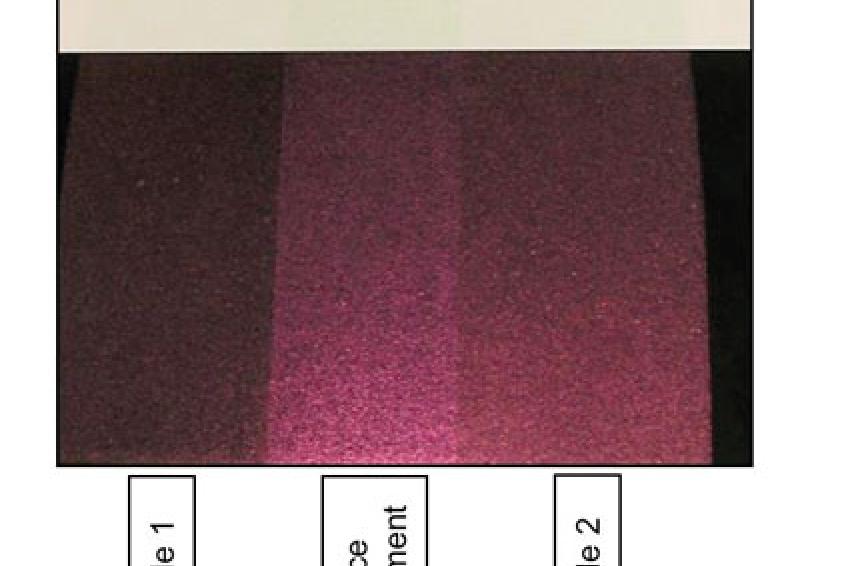Borosilicate Pigments
Superior Effects for Decorative Cosmetics
Creative - Borosilicate pigments represent a new variety of well-known pearlescent pigments. Consisting of transparent borosilicate flakes coated with high refractive metal oxides, e.g. titanium dioxide or iron oxide, these innovative pigments enable optimum interference effects in combination with outstanding transparency. Borosilicate pigments open new effect dimensions spicing up colour cosmetics with exciting eye-catching effects.
Since decades, natural mica, an alumosilicate mineral with intrinsic multi-layer structure, is used as the state-of-the-art substrate for manufacturing traditional pearlescent pigments. Due to its mineral origin, mica unavoidably shows some basic deficiencies like variations in chemical composition and bulk color due to naturally occurring accompanying elements. As commercial mica flakes need to be milled down and further processed to obtain appropriate particle size fractions for pigment production, irregular shaped micro-scale platelets with many scattering centers like edges and corners are obtained. Moreover, thickness deviations within single particles, but also among particles, result from milling causing random breakage and delamination of the flakes.
Synthetic borosilicate platelets own tailor-made characteristics like chemical composition and particle thickness. Thanks to their excellent surface smoothness, uniform individual particle thickness and excellent transparency these flakes represent an ideal substrate for achieving optimum pearlescent effects (fig. 1).
Coating of borosilicate substrates with high refractive metal oxides, e.g. titanium dioxide or iron oxide, enables the generation of exciting interference pigments. Their superior appearance compared to traditional mica based pearlescent pigments can easily be visualized by microscopic view (fig. 2). The titanium dioxide coated mica pigment with red interference color on the left hand side shows a significant color deviation from particle to particle caused by the individual background color of natural mica flakes and inhomogeneous metal oxide coating layer thickness. In contrast, the corresponding titanium dioxide coated borosilicate flakes on the right hand side appear in almost uniform red color thanks to the uncolored nature of the artificial substrate and uniform thickness of the metal oxide coating.
Borosilicate Pigments - Characteristics
In general, borosilicate pigments can be differentiated with respect to particle size fraction and composition. Transparent silver and interference effects are feasible by coating of borosilicate flakes with high refractive layers of titanium dioxide. So called earth tone colors originate from corresponding iron oxide coatings. Finally, deposition of a combination of titanium dioxide and iron oxide layers allows obtaining exciting golden shades. Particle size fractions with average size around 30 µm exhibit a very delicate and graceful appearance combined with uniform gloss.
Coarser fractions consisting of flakes with a diameter of 50 to 80 µm in average are predestinated to achieve intense interference colors accompanied by eye-catching sparkle effects. Finally, pigments with mean particle size of 100 µm that can easily be resolved by the human eye generate scintillating glitter effects.
Latest progress in R&D and advanced manufacturing technology is the key to unique high performance borosilicate pigments which do not only outperform traditional mica based effect pigments. Starting from artificial borosilicate flakes with only view scattering centers like edges and corners, a very smooth and homogeneous metal oxide layer is deposited on the substrates. Overall, pigments with striking gloss and excellent color purity are obtained. For illustration the gloss values of three borosilicate pigments with red interference color have been measured on draw down applications and visualized in the following graph (fig. 3a+b).
Comparing the gloss values of the high performance borosilicate pigment with red interference color towards corresponding customary grades is self-exploratory and outlines the superior visual performance of the optimized grade. The higher the numerical gloss value, the better the luster of the corresponding pigment.
Another important parameter contributing to the outstanding visual properties of high performance borosilicate pigments is their tight particle size distribution. In order to achieve high chromatic effects like gold, red, blue or green interference, careful control of the particle size fractions is fundamental. Especially very fine particles are detrimental as they act as scattering centers and randomly reflect the incident light beams, leading to reduced gloss and color intensity.
Importance of Borosilicate Pigments in Cosmetics
A field survey conducted with the Mintel database focusing on launches of new products containing borosilicate pigments over the last five years shows an interesting result. Borosilicate pigments were found to be the predominantly used pigments in lip color cosmetics, such as lip glosses, lip sticks or lip liners. In Europe for example, 2008 the number of new launches in this application field has been more than four times higher than in nail polish applications or eye color cosmetics.
A similar picture applies for Asian and U.S. markets - again the survey shows a significantly higher number of new product launches in the field of lip color cosmetics. At least to a certain degree, the outcome mirrors the advantageous properties of borosilicate pigments - gloss, color and transparency. These characteristics are especially beneficial in transparent or low pigmented applications like lip gloss.
Conclusion
Borosilicate pigments are consisting of artificial substrates coated with high refractive metal oxides. Progressive manufacturing technology enables superior properties, a unique combination of gloss, color and transparency. These characteristics are highly relevant for transparent or glossy application systems like lip stick or lip gloss. Due to the high transparency of the pigment flakes, borosilicate pigments are ideally suited for numerous cosmetic applications and can easily be used in admixture with other colorants giving formulators the choice to create polychromatic effects.
Since 2006 Katrin Steinbach has been part of the Cosmetic Team of Eckart and is the responsible technical service manager for Europe.
In 2007 Dr. Ulrich Schmidt joined the business line cosmetics Europe of Eckart in charge of research and development and pigment related technical service.











